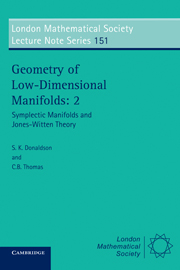Introduction
Published online by Cambridge University Press: 01 June 2011
Summary
In the past decade there have been a number of exciting new developments in an area lying roughly between manifold theory and geometry. More specifically, the principal developments concern:
(1) geometric structures on manifolds,
(2) symplectic topology and geometry,
(3) applications of Yang-Mills theory to three- and four-dimensional manifolds,
(4) new invariants of 3-manifolds and knots.
Although they have diverse origins and roots spreading out across a wide range of mathematics and physics, these different developments display many common features—some detailed and precise and some more general. Taken together, these developments have brought about a shift in the emphasis of current research on manifolds, bringing the subject much closer to geometry, in its various guises, and physics.
One unifying feature of these geometrical developments, which contrasts with some geometrical trends in earlier decades, is that in large part they treat phenomena in specific, low, dimensions. This mirrors the distinction, long recognised in topology, between the flavours of “low-dimensional” and “high-dimensional” manifold theory (although a detailed understanding of the connection between the special roles of the dimension in different contexts seems to lie some way off). This feature explains the title of the meeting held in Durham in 1989 and in turn of these volumes of Proceedings, and we hope that it captures some of the spirit of these different developments.
It may be interesting in a general introduction to recall the the emergence of some of these ideas, and some of the papers which seem to us to have been landmarks.
- Type
- Chapter
- Information
- Geometry of Low-Dimensional ManifoldsSymplectic Manifolds and Jones-Witten Theory, pp. ix - xiiiPublisher: Cambridge University PressPrint publication year: 1991

